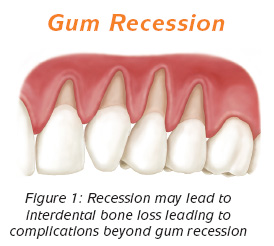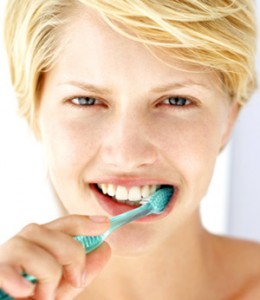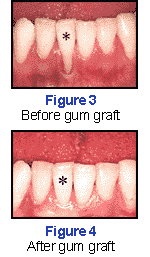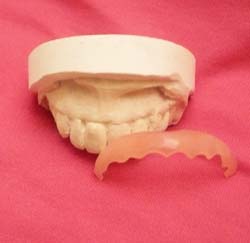The previous article discussed about the causes of a receding gum line therefore this article will proceed with the treatment options for gum recession.
Miller’s Classification of gum recession
Classification |
Clinical criteria |
Possible treatment outcome |
| Class I | full height of papillae (gum between teeth), recession within mucogingival junction
(where attached gingival meets bone mucosa)
|
100% coverage
|
| Class II | full height of papillae, recession at or beyond mucogingival junction
|
100% coverage
|
| Class III | Reduced papilla height, recession at or beyond mucogingival junction
|
Coverage only to level related to papilla height |
| Class IV | Gross flattening and loss of papillae
|
Not possible to cover |
Treatment of a receding gum line
The two commonest causes of receding gums are plaque-induced gum inflammation and toothbrush trauma, revealing dehiscence in jaw bone. Therefore basic periodontal care and correction of faulty tooth brushing techniques are the first lines of treatment. While anatomical features may contribute, these and trauma from occlusion, high frenal attachments, and impingement from restorations, etc are a secondary consideration.
The receded gum margins caused by tooth brush abrasion can only be corrected with surgical procedures that reposition the gums back into place (flap surgery). If you are comfortable with the gum line, it can be left as it is. To prevent further gum recession due to overactive brushing, soft-bristled brushes with small head size are recommended. Soft bristles are less likely to cause damage to the gums or any exposed root surfaces of the teeth and they also adapt to the shape of the tooth better. The small head size enables the toothbrush to reach the areas in the back of the mouth for cleaning the teeth in the area without hurting the mouth.
If plaque-induced gum inflammation is the contributing factor, oral hygiene should be improved and professional dental cleanings such as scaling and root planing should be done to clean the teeth and reduce the gum inflammation. Oral hygiene is especially important for orthodontic patients therefore use of interdental brushes is particularly helpful to ensure plaque control is not compromised during the wearing of an orthodontic appliance
Receding gums due to bruxism or teeth grinding, or traumatic bite would require an occlusal or bite adjustment or a splint to prevent further damage to the supporting tissues of the teeth.
Other causes of gum recession such as snuff dipping or piercings can be reduced by stopping the habit or removing the foreign material.
Mucogingival surgery
Gum recession is one of the commonest reasons for carrying out mucogingival or gum surgery. Mucogingival surgery encompasses those techniques aimed at the correction of local gum defects. If cause-specific measures are insufficient, mucogingival surgery may be indicated by using soft tissue graft to create more gums.
Grafting is subdivided into:
- Free grafts are grafts which are completely removed from their donor area. Free gingival grafts, commonly of mucosa from the palate and connective tissue, are taken and grafted to donor sites prepared by incising between attached and alveolar mucosa. This technique may successfully cover exposed root surfaces and will certainly increase the width of keratinized gingival.
- Pedicle grafts are not separated from their blood supply. Commonly used pedicle grafts are the laterally positioned flap, coronally repositioned flap and the double papilla flap. These techniques may be of some value in very narrow areas of isolated gum recession. Technically these are flaps not grafts.
Besides gum graft, guided tissue regeneration technique can also be used. The recognition that epithelium migrated along the root surface before any other cell type, after periodontal surgery, and created the long junctional epithelium which prevented new attachment, created the possibility that prevention of migration of epithelium would allow new connective tissue attachment.
Guided tissue regeneration (GTR) is essentially interposing a barrier to epithelial migration prior to completion of surgical or non-surgical therapy. Original barriers were non-resorbable. More recently resorbable membranes have been developed. These eliminate the need for a second stage of surgery. Bone grafts may be used in combination with a barrier membrane. Grafts from inorganic bovine bone matrix (Bio-oss) are in widespread use.
Emdogain is a product containing procine enamel matrix derivatives (EMD) proteins in a propylene glycol alginate gel. Enamel matrix proteins (for example amelogenin) are found in Hertwig’s sheath (which gives rise to cementum cells) and induce root formation in the developing tooth. Locally applied enamel matrix proteins may help form acellular cementum, the key tissue in the development of a functional periodontium. Case selection is important in success of regeneration techniques. They work best in cases with 3 walled defects or grade II furcation. Good oral hygiene is essential and smoking has an adverse effect on outcomes.
Untreatable gum recession can be masked with a provision of a thin acrylic gum stent or veneer made from pink acrylic. This acrylic masking can provide excellent cosmetic result if well made but only considerable for extensive recession in highly visible areas and this method is rarely used.




